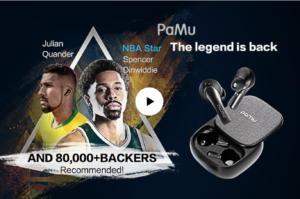Category Archives: Uncategorized
Slide TWS Earphones review
With more than $4 Million raised in crowdfunding and more than 80,000 backers, the new Slide Earphone is already 4,000% oversubscribed.
When a company describes itself as ‘the legend is back’, alarm bells instantly ring at this hubris, but when it comes to the Pamu earphones, those bells fade into the distance.
First time around, the PaMu TWS raised more than $4 million with backing from 80,000 backers including some famous US athletes.
Based on excellent sound quality, long battery life, signal stability and comfort level, this Bluetooth earphone was hugely successful. Now the so-called legend has launched the PaMu TWS Slide and demand has been rife on Indiegogo.
At time of writing, the product was already 4,000% oversubscribed and closing fast on the first million dollars. Now, this is all very well and clearly somebody has been doing some very good marketing, but is the Slide any good?
As somebody who is not exactly a fan of earphones, I wasn’t the perfect person to review this product, so I passed it on to somebody I knew could give me authentic feedback; my teenage son and fashionista.
The response was highly positive, not just because of the signal, sound quality and comfort, but because the earphones could never be dislodged from his ears whatever he seemed to do (which mainly consisted of playing basketball).
According to ‘the legend’ and, weirdly enough via a Facebook ad ten minutes ago that seems to be reading this review before I’ve even written it, those who get in early can buy the Slide for $49, a saving of 70% on the retail price of $199.
That sounds like reasonable value and if you don’t believe me or my teenage son, there are all of those US athletes to listen to… perhaps via Bluetooth and Slide earphones.
You literally heard it here first.
Bitcoins – 24 fun facts and figures
We continue our regular series of inforgraphics about bitcoins, not least where you can use them instead of ‘real money’.
Infographic courtesy of ICOWatchlist.com
Save The Children and Amido sign IT partnership
Save The Children International has appointed cloud-first technical consultancy Amido to undertake a strategically important IT project to streamline and consolidate the charity’s IT systems.
Charities are not the most original when it comes to technology, digital or IT, so it’s interesting to note they’re using one of London’s most up-and-coming cloud consultancies to do so.
The charity is a leading international children’s relief organisation operating in 120 countries. They do whatever it takes to ensure all children get access to what they deserve – a healthy start, the opportunity to learn, and protection from harm.
By partnering with Amido, Save the Children International hopes to improve its IT efficiency whilst retaining its global brand presence worldwide and national localism in the international marketplace.
“This project will open a lot of doors for us. It’s been a project high up on our strategic technology roadmap for some time. Amido’s efforts will be critically strategic to our IT efficiency so that the charity’s money is spent on helping children – which has always been, and will remain, our only focus,” said Graham Kent, Director of IT Shared Services, Save the Children International.
Amido works with brands such as ASOS, CBRE, Global Radio, London City Airport and Coats to remove friction from their customers’ online and mobile experiences to drive revenue and engagement.
From social sign-in to smart content delivery and smooth transactions, it helps brands build loyalty through customer recognition by bridging systems in a powerful way, yielding real-time results for brands and their customers.
“Amido are proud to be in a position where we can give back. By hosting the solution on Azure, Microsoft’s Cloud Platform – who donate the consumption of their platform their philanthropic arm – we have designed a solution that is scalable, faster and more flexible than what is currently in place,” said Alan Walsh, CEO, Amido.
EXCLUSIVE Q&A: George Dixon, Strategy Director, Mobsta
After more than seven years at the mega-agency MediaCom, George Dixon has turned his attention to the new Wild West of mobile; geolocation and its leading exponent Mobsta. Here he explains the need for regulation and why the industry has to wise up and deliver on its undoubted promise.
 Most of the readers of the blog are highly tech-savvy, but might not be aware of the challenges of geolocation and Mobsta’s position in the ecosystem. Pray tell us more.
Most of the readers of the blog are highly tech-savvy, but might not be aware of the challenges of geolocation and Mobsta’s position in the ecosystem. Pray tell us more.
We are a UK-based tech company working exclusively in the UK with US technology company Placecast and have a highly accurate location-powered product working with some of the UK’s biggest brands. Advertisers want to know now more than ever where their advertising £s are going. Demystifying technology is part of this as ensuring their media spend is served to their target audience in the right place and moment. We have recently demonstrated the accuracy of our technology and data at tracking visitors into store locations, proving that we can deliver on the promise of location.
But, rather like the early mobile games and advertising days, it appears there are some charlatans out there.
That’s unfortunately true. We believe our tech platform delivers on its promises of accurate and scalable location targeting and delivery. But we need more regulation in the industry so it can winnow out any companies that promise targets they will never deliver. A shake-out is definitely needed.
So it’s about delivering true geolcation results to brands that they can trust?
Now more than ever clients want to understand where their audience is and what they are doing. They need to prove the effect of their media beyond clicks and site visits. We can demonstrate the effect of a media spend on driving actual visits into stores . By offering the most accurate solution in the market as well as being able to verify location data to demonstrate its accuracy.
So what does the product actually do?
Our location platform tracks consumer’s movements based on GPS signals passed from their phones (all done anonymously). This allows us to understand whether they are in market for a new car, seen on a BMW forecourt, regular cinema goers or frequent shoppers at Tesco.
Using this data, we deliver advertising campaigns in the optimum place and moment then monitor the location behaviour of those delivered ads to see if it leads them to a different store or location in the future i.e. to visit an Audi dealer after BMW or try Sainsbury having been to Tesco in the past.
So explain to me as if I’m Joe Public, not a highly respected tech writer.
All mobile phones give off location signals when they are being used. The signals give information about where someone is and how often they go there. Mobsta’s technology allows us to monitor these signals to create relevant groups of people to target for advertising. Such as new film releases to people who frequently go to the cinema or offers in their favourite shops.
Mobsta began as a media strategy company, so how did you get here?
Our founders are highly experienced media professionals who were keen to take advantage of the growing interest in mobile advertising. You’re right in saying Mobsta started as a mobile strategy company helping monetise products and publishers’ inventory. Location was one of those products, at the time with the unique ability to target people based on their current location according to the GPS signals shared by their phones.
So give me some numbers.
We track over 45 million users each month in the UK, 500 million globally to build audiences and gather insights. This is already a $2 billion business and those numbers are only going to increase.
Walk me through the use experience.
It’s very simple; a consumer doesn’t have to do anything. They opt in to share their location when they use apps on their phone. Their data is collected anonymously, no individual information is stored. As they use their phone location relevant adverts would be sent to their phone as they browse different apps.
I understand you recently came top in a survey based on the major geolocation players?
We believe we have proved the quality of our data and platform with two tests in the last 12 months, one in the US and one in the UK. Each of which we came out on top showing key silo and verticals. We are confident we have the most accurate platform in the market and are really proud of our performance in recent tests.
Where is the team based and what’s your funding history?
We are based in London, our tech is based in San Francisco whilst we have smaller offices in New York, Amsterdam and are working with partners in Singapore, Australia and New Zealand. As for funding, we are privately owned, but we may take seed, Series A etc when the time and opportunity is right.
Well, now my readers and I know more about the growing importance of geolocation. Thanks for sharing and coming in, George.
Thanks for having me.


